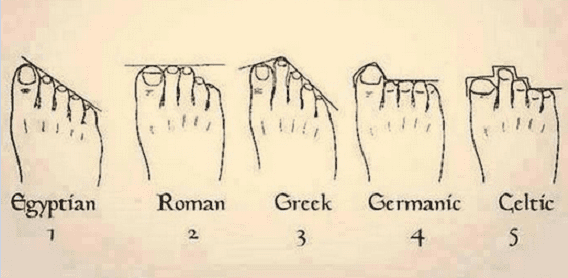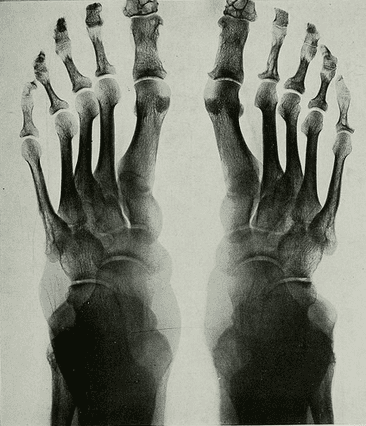Tracing your family history has become easier with digitized records, including immigration documents, newspaper articles, passenger lists, and more. But have clues to your ancestry been hiding under your socks this whole time? As a premise, it seems far-fetched – but some believe the outline of your feet can help you trace your family heritage.
What can the shape of your foot or the length of your toes say about your ancestry? Is there a fundamental truth in phalanges? Let’s have a look.
The Premise of Foot Shape Ancestry
Foot and toe ancestry suggest that by looking at the shape of your feet, you can make an educated guess about the origins of your ancestors. This theory says there are essentially five major foot shapes: Egyptian, Roman, Greek, Germanic, and Celtic feet. Each group has a particular outline and arrangement of toe lengths, which hint at the population origin.

Celtic Feet
According to feet ancestry, Celtic feet have the most complex shape, with a large but short first toe, an exceptionally long second toe, and the remaining toes tapering to a small pinky. Celtic feet appear to be something of a combination of the Germanic and the Greek toe shapes, sharing the larger first toe of the German with the variety of lengths (especially in the case of the second toe) of the Greek.
Compare your toes to Celtic feet. Maybe you’ve got the luck of the Irish in you. Or maybe on closer inspection you’ve got a long first toe with all the others tapering down from there? In that case, you may have the so-called Egyptian foot.
But, can these archetypal shapes really tell us anything about our ancestry? What does science have to say about this idea?

Problems with Foot Shape Ancestry
It’s important to note that there is no scientific evidence that our feet conform to archetypal shapes, or that foot shape ancestry is an accurate way to trace your heritage. Data collected on multiple populations show a trend of their second toe being the longest (as seen with the Greek foot). For example, the Ainu people, an indigenous community in Japan, exhibit the second toe as the longest in 90% of individuals (an extreme example). However, it would be bizarre to think that the Ainu originated in Greece.
If we consider the claims of toe ancestry as a potential way to categorize an actual genetic group, then we need to look critically at the words used to describe the foot shapes. Why Egyptian, Roman, Greek, Germanic, and Celtic feet?
Where These Shapes Came From
Speaking primarily of the Egyptian, Greek, and Roman feet ancestry shapes, these are the idealized foot form in their respective culture’s art. For example, the Greek foot is one you can see on the statues that adorn the Acropolis (also the Statue of Liberty as it happens). While this may indicate that a majority of Greeks of that period had a foot shape like that one, it is much more likely that that was simply the standard of beauty at the time.
The Myth of “Original” Populations
Many modern ideas surrounding the concepts of “Germanness” and “Egyptianness” are just that: modern. The idea of an “ethnic German” was one essentially constructed in the 19th century when that area of Europe — traditionally divided into multiple different regions such as Prussia, Saxony, and Bavaria – was unified as the State of Germany. The “Germans” as the Romans knew them were a diverse mix of people and cultures. Romans called this group Germans because Rome saw them as barbarians and didn’t care to learn more about them.
The idea of foot shape ancestry and toe shape ancestry is rooted in a similar misconception that populations were ever made up entirely of one group. Human populations have migrated, fought, mixed and mingled throughout time. The idea that there was ever a monolithic population with Celtic feet is rooted in a grossly oversimplified version of how and where humanity has lived.
So, can you learn about your family origins from your foot shape? Possibly not. However, it is fun to have a look – and this idea could help inspire younger generations to learn more about their ancestors.
